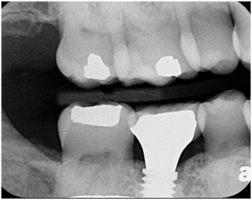-
0
Patient Assessment
- 0.1 Patient Demand
- 0.2 Anatomical location
-
0.3
Patient History
- 2.1 General patient history
- 2.2 Local history
-
0.4
Risk Assessment
- 3.1 Risk Assessment Overview
- 3.2 Age
- 3.3 Patient Compliance
- 3.4 Smoking
- 3.5 Drug Abuse
- 3.6 Recreational Drug and Alcohol Abuse
- 3.7 Condition of Natural Teeth
- 3.8 Parafunctions
- 3.9 Diabetes
- 3.10 Anticoagulants
- 3.11 Osteoporosis
- 3.12 Bisphosphonates
- 3.13 MRONJ
- 3.14 Steroids
- 3.15 Radiotherapy
- 3.16 Risk factors
-
1
Diagnostics
-
2
Treatment Options
-
2.1
Treatment planning
- 0.1 Non-implant based treatment options
- 0.2 Treatment planning conventional, model based, non-guided, semi-guided
- 0.3 Digital treatment planning
- 0.4 NobelClinician and digital workflow
- 0.5 Implant position considerations overview
- 0.6 Soft tissue condition and morphology
- 0.7 Site development, soft tissue management
- 0.8 Hard tissue and bone quality
- 0.9 Site development, hard tissue management
- 0.10 Time to function
- 0.11 Submerged vs non-submerged
- 0.12 Healed or fresh extraction socket
- 0.13 Screw-retained vs. cement-retained
- 0.14 Angulated Screw Channel system (ASC)
- 2.2 Treatment options esthetic zone
- 2.3 Treatment options posterior zone
- 2.4 Comprehensive treatment concepts
-
2.1
Treatment planning
-
3
Treatment Procedures
-
3.1
Treatment procedures general considerations
- 0.1 Anesthesia
- 0.2 peri-operative care
- 0.3 Flap- or flapless
- 0.4 Non-guided protocol
- 0.5 Semi-guided protocol
- 0.6 Guided protocol overview
- 0.7 Guided protocol NobelGuide
- 0.8 Parallel implant placement considerations
- 0.9 Tapered implant placement considerations
- 0.10 3D implant position
- 0.11 Implant insertion torque
- 0.12 Intra-operative complications
- 0.13 Impression procedures, digital impressions, intraoral scanning
- 3.2 Treatment procedures esthetic zone surgical
- 3.3 Treatment procedures esthetic zone prosthetic
- 3.4 Treatment procedures posterior zone surgical
- 3.5 Treatment procedures posterior zone prosthetic
-
3.1
Treatment procedures general considerations
-
4
Aftercare
Posterior Solution
Key points
- The components of the NB Posterior Solution are specific.
- Utilization of the system provides for immediate placement and provisionals.
- Following proper healing ideal soft tissue profiles can be developed optimizing the final restoration.
With the development of the NB posterior solution the ability to restore posterior dentition in a predictable, esthetic, functional and cement free option is available. The component parts of the system are: The NobelActive WP (Wide Platform) implant, PEEK anatomic-shaped temporary and healing abutments, full contour zirconia (FCZ) tooth replacement, and Angulated Screw Channel (ASC) design with Omnigrip tools. When coordinated with 3D digital treatment planning from NobelClinician, this will optimize implant placement.
The posterior solution is ideally suited for the replacement of molars. With the use of the NobelAcitve WP implant, there are a number of immediate advantages. The thread design of the Active implant provides for implant stability immediately with higher torque values possible (up to 70Ncm). Platform shifting enhances soft tissue response and potentially maintains bone height at the most coronal aspect of the implant. With the wide platform implant the anatomical requirements of the molar root form are addressed. The shape and thread design can allow for immediate placement (and placement of the provisional ) in extraction sockets.
Coupled with digital treatment planning (NobelClinician) and placement from a guided surgical platform (NobelGuide ) the placement of the implant will maximize soft and hard tissue profiles and enable the best placement for the ideal restorative outcome.
Once the implant is placed the PEEK temporary abutment can be connected and provisional material added to it. This will enable the clinician to shape the final restoration to mimic natural tooth root morphology and emergence profiles. Once osseointegration phase is complete, the environment is ideally set for impressioning the implant and soft tissue. The provisional is removed and fixture level impression is secured (open or closed tray options are available).
The final restoration is fabricated in full contour zirconia – the elimination of veneering porcelain enhances overall strength and eliminates chipping. The ASC will allow for a screw retained restoration even with deviation of the access channel if the implant has been placed off of the vertical access (up to 25°). The design of this restoration has a built in platform switch that maximizes osseous retention by moving the micro gap in a horizontal fashion.
Thus with the NB full posterior solution a predictable, esthetic, functional, screw or cement retained and superior restoration is delivered to the patient that will provide years of service.

Figure 1: Example of platform switch with bone on the platform
Digital Textbooks
In fact, some molar spaces have a 12.0 mm mesiodistal dimension and, therefore, with a 4.0 mm diameter implant even a well-contoured crown will reach the limits of the recommended lateral extension.
Additionally, if the implant is not centered beneath the restoration’s occlusal surface, the occlusal loading forces can be greater and may overload of the abutment screw or implant.
